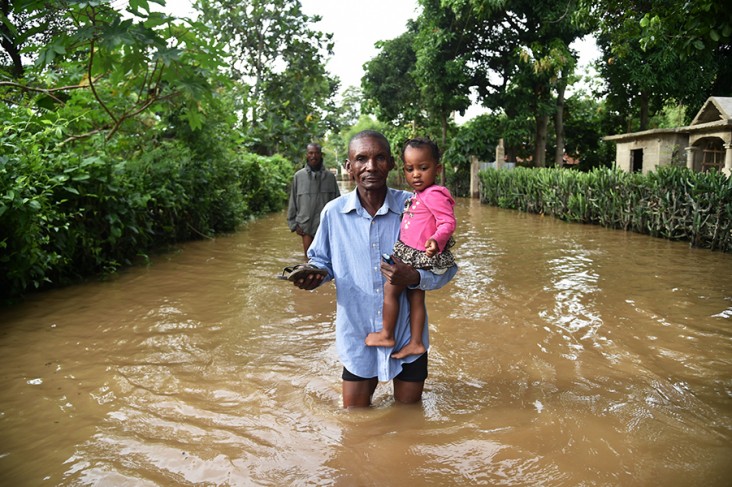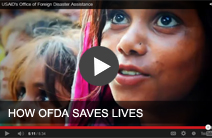- What We Do
- Agriculture and Food Security
- Democracy, Human Rights and Governance
- Economic Growth and Trade
- Education
- Ending Extreme Poverty
- Environment and Global Climate Change
- Gender Equality and Women's Empowerment
- Global Health
- Water and Sanitation
- Working in Crises and Conflict
- Disaster Assistance
- Political Transition Initiatives
- Conflict Mitigation and Prevention
- Countering Violent Extremism
- Disaster Risk Reduction
- Peacebuilding and Reconciliation
- Providing Safe & Secure Environments for Development
- Recovering From Crisis
- Resilience
- Tech Challenge for Atrocity Prevention
- World Humanitarian Day
- U.S. Global Development Lab

Key Developments
Hurricane Irma is passing north of Haiti on September 7, and impacts on the country remain undetermined. Staff from USAID's Office of U.S. Foreign Disaster Assistance and USAID’s Office of Food for Peace (USAID/FFP) based in the capital of Port-au-Prince are closely tracking the hurricane and remain in close communication with national emergency officials, other donors, UN agencies, and international NGOs in Haiti regarding their hurricane preparations and response capabilities.
USAID partners, including the UN World Food Program (WFP), the International Organization for Migration, CARE, Catholic Relief Services, Cooperazione Internazionale (COOPI), and the American Red Cross have begun pre-positioning teams and relief items in strategic locations to enable immediate access to potentially affected areas.
According to the International Federation of Red Cross and Red Crescent Societies (IFRC), the American Red Cross has pre-positioned staff in Haiti’s northern departments to facilitate rapid damage assessments once the hurricane has passed and to support Haiti Red Cross Society relief operations.
USAID/FFP is preparing to assist hurricane-affected households across Haiti and the broader Caribbean region with emergency food assistance as needed and requested by affected countries. In late August, USAID/FFP provided WFP with a $4 million contribution to support the local and regional procurement of emergency food assistance to bolster pre-positioned food stocks. As of September 6, WFP had pre-positioned approximately 3,300 metric tons (MT) of emergency food assistance—sufficient to support the immediate needs of an estimated 150,000 individuals for thirty days—across Haiti. The
UN agency reports having pre-positioned food commodities, including cereals, beans, and vegetable oil, to meet the immediate food needs of up to 80,000 people in northern Haiti. WFP has also secured additional food commodity storage in the north of Haiti and has prepared transportation and logistics options to move additional emergency food commodities from Port-au-Price to hurricane-affected areas in the north, if needed.
Learn more about USAID's Caribbean Hurricanes response efforts
Background
Haiti, an island in the Caribbean region, is vulnerable to recurrent floods and landslides associated with the rainy and hurricane seasons. Since the January 2010 earthquake and October 2010 cholera outbreak, USAID/OFDA has focused both on providing immediate response to affected populations and on supporting disaster risk reduction (DRR) programs that promote local and national self-sufficiency in disaster preparedness, response and management. Since 2010, USAID/OFDA has provided nearly $95 million to support stand-alone DRR programs throughout Latin America and the Caribbean, including approximately $20.4 million in funding to support DRR efforts in Haiti. In addition to stand-alone DRR programs, USAID/OFDA contributed nearly $44 million to support programs integrating preparedness and mitigation activities into early recovery and transition programs in response to the January 2010 earthquake and subsequent cholera outbreak in Haiti.
Since 2011, USAID/OFDA has supported IOM to pre-position emergency relief supplies in the event of disasters—such as flooding and landslides—during the rainy and hurricane seasons, as well as to develop GoH personnel capacity to manage facilities and deploy supplies when necessary. Pre-positioning relief commodities—including plastic sheeting, hygiene kits, and water containers—ensured that relief supplies were available for distribution to affected populations immediately following Hurricane Matthew.
Hurricane Matthew made landfall in Haiti on October 4, resulting in nearly 550 deaths and affecting an estimated 2.1 million people, including 806,000 people requiring immediate food assistance, according to the Government of Haiti Directorate of Civil Protection. The storm brought destructive winds, heavy rainfall, and dangerous storm surge, resulting in widespread flooding and extensive damage to crops, houses, and infrastructure primarily in Grand’Anse and Sud Departments. Learn more about USAID's Hurricane Matthew response efforts.








Comment
Make a general inquiry or suggest an improvement.